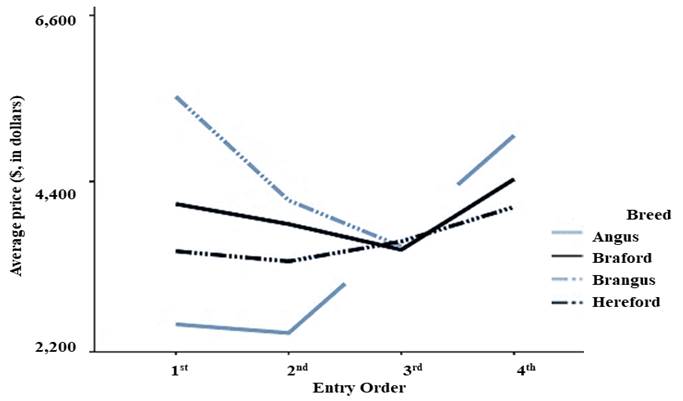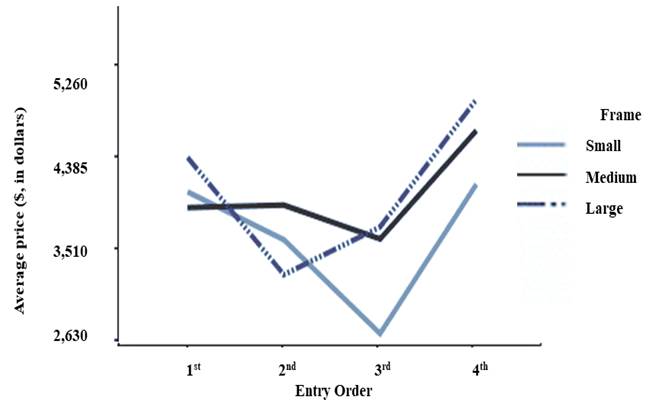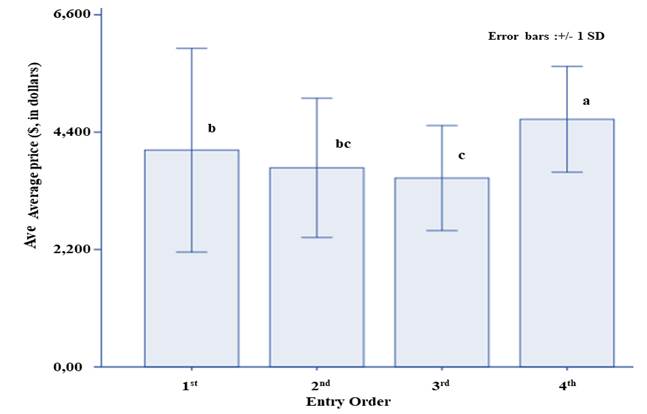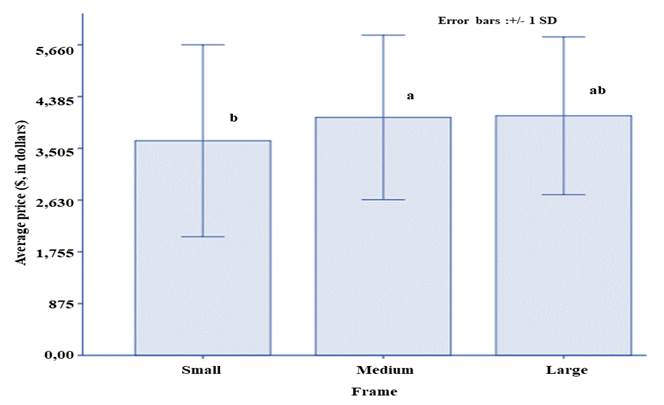Introduction
Brazilian cow-calf systems typically consist of bulls, breeding cows, heifers and calves. In these systems, the number of bulls account for about 3 to 5 % of the animals1, and approximately 25 % are replaced annually, this constituting a significant component in the production cost2. This bull for use, it is usually provided by producers of pure breeds, which should know the value of genetic and phenotypic characteristics that affect the selling price3. Furthermore, as profit margins in cow-calf systems tend to be narrow, to increase profitability farmers must aim at breeding animals which return higher productivity whilst meeting market expectations4,5.
Nevertheless, several variables affect bulls selling price, such as the breed, muscularity, frame, age and scrotal circumference3,6, but not all livestock buyers are looking for the same characteristics. Often, those features that would best meet the buyer’s requirements are overlooked in detriment of others such as animal conformation7,8, and should be analysed and understand to develop rational marketing strategies.
Moreover, since Brazilian bulls are usually traded at auctions, investigating the extent that each factor might influence and bulls selling prices could increase the competitiveness of the sector. However, price formation is complex and influenced by endogenous and exogenous factors such as supply and demand forces, stocks carried over, farmers’ decision-making and the buyers’ behaviour during purchase. Therefore, since qualitative and quantitative characteristics influence the sale of the animals9, this research analyses livestock auction arrangements and the most relevant animal features perceived by bull buyers, which affect livestock auction prices.
Material and methods
Data from the sale of 760 bulls was collected from eleven different livestock auctions held in six towns (Alegrete, 1; Dom Pedrito, 3; Esteio, 1; Santa Vitória do Palmar, 1; Santana do Livramento, 3, and Uruguaiana, 2) in the state of Rio Grande do Sul, Brazil, from August to November 2013. The livestock auctions were held annually as part of the traditional bulls’ sale calendar. The auctions were conducted by different auctioneering companies and were typically located at agricultural fairs. However, in two cases the auctions took place at farms (Uruguaiana, 1; Dom Pedrito,1). All bulls were certified by the respective breeder’s associations and were offered between 2 to 3 ys of age.
Following established literature on the matter, a standard form was devised to collect relevant information on the animals’ characteristics which could influence buyers’ decision-making. The attributes collected consisted of the breed, muscularity score (MUSC), frame score (FRAME) and body condition score (BCS) of the bulls. The breeds that were analysed in the auction were: Angus, Brangus, Hereford and Braford.
The Angus breed originated in Scotland and development in Brazil occurred in different regions, especially the cattle herds in southern Brazil. It is a breed of moderate size, naturally polled and can be black or red in colour10. The Brangus is formed by Zebu with Angus, and thus has the predominant characteristics in Angus, such as carcass quality, pigmentation, fertility and precocity; with those of Zebu, which are adaptability and rusticity11.
The Hereford breed originates from the County of Hereford in England. The breed is coloured dark red to red-yellow, with a white face, crest, dewlap, and underline. The animals can be polled or with short thick horns that typically curve down at the sides of the head12. The origin of the Braford breed was by a cross between a Hereford x Brahman or Hereford x Nelore breeds. Currently, the Braford breed has fertility, maternal ability, precocity and meat quality of Hereford with the ability to adapt to the tropics, rusticity and carcass yield of zebu12.
As for FRAME, scores from 1 to 3 were given according to the height measured from animals’ hip as proposed and adapted from the works of the Beef Improvement Federation13. FRAME 1 represented heights from 104 to 114 cm, typically of smaller biotypes; FRAME 2 varied from 119 to 129 cm, representing biotypes of average height; and FRAME 3 were typical of animals of large biotype.
Regarding the MUSC, the bulls were classified according the scores 1 - 3, where MUSC 1 represent those of concave muscular profile, narrow width between the hind legs, prominent hip bone and tapered thigh; MUSC 2 was typical of animals of average muscularity, muscular profile less convex, hip bones slightly prominent; and MUSC 3 were those animals of better muscularity, convex muscular profile, large width between the hind legs, well rounded top line and thicker thigh.
As for the BCS of 1 to 5 were given based and adapted14. Those showing a BCS 1 were typically of low muscularity, very lean, and whose ribs were visible; BCS 2 represented lean bulls with low rib fat cover which also presented protruding hip bones; bulls with BCS 3 score had moderate muscular cover whose ribs were practically covered; BCS 4 represented bulls of good muscular cover and which had some fat cover; and BCS 5 were typical of bulls with excess fat cover at the tail fold and ribs.
Information available from sales catalogues published by the livestock auctioneers regarding general sale’s conditions (payment terms which could attract a discount for payments paid at sight or in instalments varying from up to 15 or 20 mo); body weight (BW) and scrotal circumference (SC) were used. The bulls were sold following a typical English style auction where the bids were made until the price reached its maximum. To analyse the effect of entry order (ORDER) on the selling price at each auction, the animals were grouped into four stages consisting of 1st quarter (batch 1 to 9), 2nd quarter (10 to 17), 3rd quarter (18 to 29) and 4th quarter (remaining batches). The ORDER was registered against the animals’ initial and selling price and the likely sale terms.
For the evaluation of the equivalent fat cattle (EFC), the price of one bull sold in the auction was divided by the price of bullocks’ in the same period (equivalent price obtained in 2013)15, and with that was determined the number of bullocks’ (EFC= 450 kg) that is equivalent to the price of one bull.
Using SPSS software version 20.0, statistical analysis of the data, including frequency, mean, median, maximum and minimum values, standard deviation of price. A linear generalized model was used to evaluate the interaction of each variable with the purchase price of the bulls, and the best model is presented by the Equation 1:
in which:
P= purchase price;
β= breed;
φ= frame;
ω= muscularity;
ψ= entry order;
ϕ= body condition score;
e= experimental error.
An ANOVA with Tukey post-hoc was used to compare the differences between the categories that influenced the purchase price of bulls. All analysis considered a 95% level of significance and were realized in the SPSS 20.0.
Results
The average bulls’ market liquidity in the auctions was approximately 90 %, and the purchase price presented a great price range. The purchase price ranged between $1,645.00 and $14,473.00 with an average price of 4,092.00 dollars (Figure 1). Usually, sellers and buyers referred to the equivalent fat cattle parameter, in this research, the EFC ranged from 2.5 to 6.4 bullocks.
There was no association between weight and price; in addition, scrotal circumference did not this related to the price. As for the characteristics evaluated subjectively, such as muscularity and body condition score were also not associated with the final price of the bulls at auctions. In this research, no bull presented a BCS below three (average 3.88) and bulls with light muscularity were to be Angus and Brangus with 63.2 and 31.6 % light muscularity respectively. Only 2.7 % of the animals sampled exhibited a light muscularity whilst 85.5 and 11.6 % of the sample presented a moderate and strong muscularity respectively. Moreover, all the lighter animals were sold during one auction location only, thus contributing to the outliner effect as the selling prices of such an auction might have been higher than in other auction locations.
However, other variables also influenced the bulls market6 as it was seen, in the best model representing the factors influencing the purchase price of bulls in auctions. It was found that the price in 2013 was influenced by the breed and frames of bulls, as well as the entry order of the animals in the auction. The purchase price was also influenced by the interactions of breed and entry order and the interaction of frame and entry order.
The price payed for which breed of bull differ between the entry orders. All breeds presented declining prices from the first to the second entry order and increasing purchase prices from the order third to forth. However, from the second to third order Angus and Brangus increased while Hereford and Braford decreased in the purchase price (Figure 2).

Figure 2 Effect of the interactions between breed and entry order over the purchase price of bulls sold in auctions in the state of Rio Grande do Sul, Southern Brazil
Large bulls received higher purchase prices in all orders, except in for the second order of entry, in which medium and small animals were more valued (Figure 3). The purchase price in the fourth entry order was higher than in all the others, and there was also a difference between the first and third entry orders, in which the latter presented the lowest prices (Figure 4). The purchase price of smaller bulls was lower than that of medium-sized animals, and the price of the latter did not differ from that of larger bulls (Figure 5).

Figure 3 Effect of the interaction between frame and entry order over the purchase price of bulls sold in auctions in the state of Rio Grande do Sul, Southern Brazil

Figure 4 Effect of the entry order the purchase price of bulls sold in auctions in the state of Rio Grande do Sul, Southern Brazil

Figure 5 Effect of the frame over the purchase price of bulls sold in auctions in the state of Rio Grande do Sul, Southern Brazil
In the present study it was verified that Angus bulls obtained the highest prices in relation to the breeds Brangus and Hereford, although the supply of Angus animals was only 15 % (Figure 6). However, this may reflect the number of auctions, since one of these is on the market for around 60 yr. Braford and Hereford bulls were marketed in 9 and 10 auctions, respectively. This must have contributed to the fact that they received the lowest prices.
Discussion
The high liquidity in the auctions could be attributed to the high demand for bulls in the year of the study (2013). That could also reflect the consolidation in auction houses, which have been marketing for at least 10 yr. Moreover, the reputation of bull breeders historically can exercise some influence in the buyer decisions 3,6,16. In addition, the state of Rio Grande do Sul is a major supplier of bulls of European and synthetic breeds to the other states of Brazil.
Moreover, in general, the higher the price, the lower the frequency of animals sold, because bulls with higher phenotypic characteristics tend to require greater care regarding maintenance, increasing their future cost in the farm. This is more concerning since most bulls are sold to typically commercial livestock farmers17. The equivalent fat cattle (EFC) found in this research indicated that farmers engaged in the breeding bulls attended the needs of different cattle farmers. However, the large majority of bulls sold aimed to meet the demand of commercial herds, as only 10 % of the bulls sold at equivalent fat cattle (EFC) 6.4 or higher. This asymmetric price variation is an indicative of product differentiation, as bull buyers tended to favour animals whose phenotypical characteristics are not directly proportional to the observable parameters18.
Despite the lack of association between weight and price in this research, this has been found in previous researches19,20,21, possibly because weight influences bulls’ appearance and could infer a likely weight gain potential, a desirable feature for breeders17. However, that cannot be assessed only by visual observation, and too much an emphasis on weight at the sale can be detrimental to younger bulls which are lighter, but might be genetically superior. Furthermore, overfeeding also could produce heavier animals that can result in mounting difficulty and low semen quality22. Therefore, the potential genetic contribution that a heavier bull could have in a herd may be impaired if these animals are not healthy enough by being unable to search for females in heat and reproduce. Since fat bulls with excess fat deposited at the base of the tail need to lose a lot of weight to be used to work in the field.
Accordingly, the scrotal circumference, which was not related to price, is another important phenotypical characteristic usually publicised by catalogues, and one of the most important predictor of fertility and precocity in bulls19,23. However, should SC be obtained during the sales, other environmental effects could be masking the true bull’s potential, as overfeeding.
Despite being a favourable characteristic in beef herds, muscularity was not related to higher prices, which could be explained by the low representativeness of the sample, since only 2.7 % exhibited light muscularity, whilst 85.5 % and 11.6 % presented moderate and strong muscularity, respectively. Moreover, all the lighter animals were sold during one auction, contributing to the outliner effect as the purchase prices of such an auction. Nevertheless, muscularity is an important phenotypic trait as it influences buyer’s evaluation at the purchase, since it is associated to future meat production. Hence, the selection for muscularity should be optimized, not maximized to avoid birth difficulties24.
Body condition score indicates an adequate nutritional and it is an important visual feature for buyers. Hence, since the high nutritional level may exacerbate bulls’ physical qualities, it was expected that buyers favoured bulls with larger BCS, but this feature did not influence the purchase price.
The purchase price was higher in the first and last (4th) entries, and the latter presented the highest prices. The reduction in purchase price as the entry order progresses gets to the middle of the auction, second and third quarters, could be attributed to a decreased interest by the buyers, as they could have their needs fulfilled at the beginning of the auction. Nevertheless, the reduction in values according to the entry order can be also explained by a decrease of the relative quality of bulls. Moreover, as the auction progresses the weight of the animals entering the ring diminishes, also reflecting in a lower purchase price.
Nevertheless, the highest prices were seen in the last quarter of the auction, mainly for Angus bulls, which also presented higher prices at the end of the auction, as well as Braford and Hereford bulls. The lack of Brangus bulls at the final quarter and of Angus at the third quarter could be a major influence in this analysis.
Moreover, small animals received lower purchase prices except in the second quarter, probably because buyers believed that larger bulls could be more efficient in breeding, presenting a lower risk. However, in some breeds, such as Angus, Charolaise, Simmental and Polled Hereford, the frame of bulls increased the purchase price, especially in the USA25,26, as seen in the calf market27. Therefore, the removal of extremes (small and large animals) can be helpful to standardize the herd.
For breeds, Angus bulls attracted higher prices than Hereford and Brangus bulls, which was expected as it was the results of previews studies in the USA3,20. Despite the supply of Angus bulls of only 15 %, that did not negatively affect the purchase price. In addition, the small share of Angus sales derived from two auction locations, but one auction event is very traditional and has been taking place in the same site for over 60 yr. The tradition and reputation of the auctions’ events can exercise a positive effect on the price. Moreover, Angus and Brangus were sold only in two traditional events (Uruguaiana and Dom Pedrito).
In addition, the different prices between breeds, depended on factors involving buyers’ personal preference, soil and climate conditions, market trends and supply/demand relationships. Despite most Brazilian cattle is of zebu herd, the Southern latitude present overall different environmental characteristics with lower average temperatures and natural pastures (pampa grassland). Hence, the widespread use of European breeds (Angus and Hereford) and commercial synthetic breeds (Braford and Brangus) is evidence of how well adapted the cattle is to those conditions. The value of a breed per se reflects the commercial circumstances and the characteristics of the auctions (e.g. time to market). Besides the characteristics of the bulls, there are other factors related to the auction system that influence the formation of bull’s purchase price. However, for more efficient results in the production, actual production weights (birth, weaning, and yearling weight), and production expected progeny differences (EPD’s) (birth, weaning, and yearling) must be considered.
Conclusions and implications
The bulls’ purchase price in livestock auction cannot be determine by only one variable, but the frame and breed constitute the main phenotypic characteristics that influence in price. In addition, the order of entry of bulls in the ring influence the purchase price. These results may be useful to both sellers and buyers of bulls, who need to plan for their purchases and investment. A better understanding of the variables in a bull that would most affect productivity would be a useful instrument to for the purpose of efficient allocation of resources, ensuring liquidity for stocks and possibly a better margin in marketing. In addition, the supply of bulls could be planned according to the expected demand and product carcase specifications.











 texto en
texto en 




